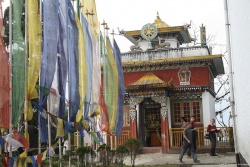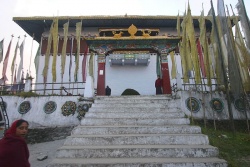Pemayangtse Monastery
The Pemayangtse Monastery is a Buddhist Monastery in Pemayangtse, near Pelling in the northeastern Indian state of Sikkim, located 140 kilometres (87 mi) west of Gangtok. Planned, designed and founded by Lama Lhatsun Chempo in 1705, it is one of the oldest and premier Monasteries of Sikkim. It is not only one of the oldest Monasteries of Sikkim but also the most famous in west Sikkim. Originally built by Lhatsun Chenpo in the 17th century, as a small Lhakhang, it was subsequently enlarged during the reign of the third Chogyal Chakdor Namgyal who was considered as Lhatsun Chenpo's third reincarnate, Jigme Pawo. The Monastery follows the Nyingma Order of Tibet Buddhism and controls all other Monasteries of that Order in Sikkim. The Monks of this Monastery are normally chosen from the Bhutias of Sikkim.
The Monastery was built for "pure Monks" (ta-tshang) meaning "Monks of pure Tibetan lineage", celibate and without any physical abnormality. This practice is still retained. Only the Monks of Pemayangtse Monastery are entitled to the title "ta-tshang". The head Lama of this Monastery had the unique privilege of anointing the Chogyals of the erstwhile monarchy of Sikkim with holy water. Pemayangtse means "Perfect Sublime Lotus", and is said to represent one of the four plexus of the human Body. The Pemayangtse Monastery is part of Buddhist religious Pilgrimage circuit starting with the first Monastery at Yuksom known as the Dubdi Monastery, followed by Norbugang Chorten, Tashiding Monastery, the Rabdentse ruins, the Sanga Choeling Monastery, and the Khecheopalri Lake.
History
The history of the Monastery is very closely linked to the reign of Chodar Namgyal at Rabdentse. Chador, a very religious person, had taken several initiatives to the spread of Buddhist Religion in Sikkim. He had decreed that the second of every three sons of Bhutia family shall be ordained a Monk of the Pemayangtse Monastery. During his reign, the Guru Lhakhang Tashiding (1715) was built. He not only patronized Buddhist religious places but also introduced the religious dances (mystery plays) to highlight the martial and native traditions of Sikkim.
Geography
The Monastery located on a hill top in the west district of Sikkim is at the beginning of the popular Dzongri trek route - Yuksom-Dzongri-GoechhaLa is a trek of 46 km, which was started prior to 1960 and which is the most popular trek in Sikkim) to the Kanchendzonga range of hills and Kanchendzonga National Park (KNP). It is 7 kilometres (4.3 mi) away from Geyzing on the main Pelling road and 44 km away from Pelling. From Upper Pelling on the Geyzing-Pelling road near a Stupa, a bypass track of 1.3 km leads to the Monastery; Pelling (2,040 metres (6,690 ft)) is the nearest town to the Monastery. The view of Mount Khanchendzonga is said to be a commanding and impressive view from this Monastery.
Architecture
The Monastery, located at an elevation of 2085 m, is built with scenic backdrop of snow capped mountains on two sides. Built as a three storied structure, the Monastery depicts paintings on its walls and Statues of saints and Rinpoches, deified in various floors. The Monastery was damaged by earthquakes in 1913 and 1960. However, it has been refurbished several Times. The Monastery belongs to the Nyingma Order (established in the 8th century by Padmasambhava) and characteristic feature seen in this Monastery is of Statues of Padmasambahva and his two consorts.
In the main Prayer hall (1,500 square feet (140 m2) area), the Dukhang or Lakhang, the main temple, which has colourfully painted doors and windows, depict Tibetan designs. The main statue of Padmasambahva (also known as Guru Rinpoche who revived Buddhism In Tibet and was also the propagator of Vajrayana or tantric Form of Buddhism) seen here is in his wrathful Form as Dorje Bhurpa Vjarakila with multiple heads and arms.
The Monastery, which overlooks the Rabdantse ruins, has well manicured Gardens within its compound where the residential accommodation for the Monks is also located.
The first floor of the Monastery has a notable collection of ancient Buddhist antique idols, scriptures as well as sculptures and decorated paintings. Padmasambahva's eight incarnations in fierce Form are also seen here. Of particular note is a seven-tiered painted wooden structure, portraying Guru Rimpoche's Heavenly Palace known as "Sanghthokpalri" also spelt "Zandog-palri", on the top floor of the Monastery. The painting has scenes of rainbows, angels with "whole panoply of Buddhas and Bodhistvas". This structure was constructed by Dungzin Rimpoche over a period of 5 years.
Festival
The Chaam festival (Monk dance) is held every year, on the 28th and 29th day of the 12th lunar month of the Tibetan Calendar corresponding to February of the Gregorian Calendar. It is performed by the lamas of this Monastery. The lamas dress up as Mahakala and Guru Drag-dmar in colourful costumes for the dance performance. Pilgrims from all parts of Sikkim visit the Monastery to witness this festival. On this festive occasion, which marks the conclusion of the Losar (Tibetan New Year), on the last day of the festival, a very large and impressive embroidered scroll is displayed. Fireworks display is also a part of the concluding function, symbolizing driving away of Evil Spirits. There are 108 Monks in this Monastery and they are identified by the red hats that they wear.
Refurbishments & Preservation Efforts
The Monastery has withstood over centuries with the rigours of nature, including earthquakes and other common calamities found in high altitude areas. As a result the Monastery has been damaged Time and again which can be spotted in the interiors, especially in the first floor. The Monastery has gone through series of refurbishments and preservation efforts to strengthen the structure. Most notably, on the rear left corner of the Monastery the roof was tied to chains which were then planted to solid concrete floor to enable it to with stand the monsoon winds.

